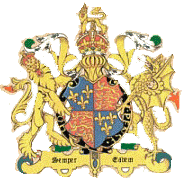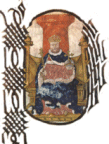Jane
HOWARD
(C.
Westmoreland)
Born: 1533 / 1537
Died: 1593
Buried: 30 Jun 1593, Kenninghall, Norfolk, England
Father: Henry
HOWARD (E. Surrey)
Mother: Frances De VERE
(C. Surrey)
Married: Charles
NEVILLE (6° E. Westmoreland) ABT 1563
Children:
1. Margaret
NEVILLE
2. Anne
NEVILLE
3. Thomas
NEVILLE WESTMORELAND
4. Catherine NEVILLE
5. Eleanor NEVILLE
Eldest daughter of Henry Howard, Earl
of Surrey and Frances De Vere. Her
early education was in the hands of Hadrianus Junius. After the
execution of Surrey
in 1547, Jane and
her sisters Catherine and Margaret, were entrusted to their aunt, Mary Howard, Duchess of Richmond. The girls were educated by
John Foxe, who taught
them Greek and Latin and had them compose poetry. He equated Jane’s
learning with that of the most learned men of her times. She was well educated but perhaps not
the most clever of women when it came to understanding political machinations.
About this time the Countess of Surrey faded out of her children's lives
by remarrying. Her husband was Thomas Staynings, a country gentleman. After Thomas
Howard had succeeded his grandfather it was suggested to Bishop
Gardiner that Lady Surrey should have the ordering of her
daughters, Jane and Margaret Howard, but they stayed on at
Kenninghall. A more important duty fell to the
Countess in Dec 1557 when she
acted as chief mourner at the funeral of her sister-in-law, the
Duchess of Richmond. Thus she discharged her debt to the
woman who for five difficult years had acted as foster-mother to her own
children. Jane went to
court in 1558/9. Around 1563, she married Charles Neville, 6th E.
of Westmoreland. They had four
daughters, Margaret, Anne, Catherine and Eleanor, and a son,
Thomas.
In 1569 Westmoreland,
Thomas Percy, 7° Earl of
Northumberland, and the earls of Cumberland and Derby plotted a
rebellion to rescue Mary Queen of
Scots,
marry her to Jane’s brother, Thomas Howard, 4th Duke of
Norfolk, and restore Catholicism to England. When
Norfolk was arrested,
he advised the earls to abandon their plans, but in a meeting between Northumberland
and Westmoreland at
Brancepeth it was
Lady
Westmoreland who
persuaded the two earls to take up arms.
Of her brother’s defection she
is said to have remarked, “What a simple man the Duke is to begin a
matter and not go through with it”. To the earls, who were considering
flight or submission to the Queen, she said, “We and our country were
shamed forever, that now in the end we should seek holes to creep into”.
She goaded them until, on 14 Nov 1569, they began the first uprising
England had seen since 1554, and Jane had more to do with raising the troops than her husband
did. Sir George Bowes
records, in a letter of 15 Nov 1569, that when Markenfield, Reed, and
other rebels left the Earl she 'braste owte agaynste them with great
curses, as well for their unhappye counselling as nowe, there cowerd
flyghte'.
At Brancepeth Lady Westmorland swayed the waverers, when it seemed
they might once more depart to their houses, and in tears harangued them:
‘We and our country were shamed for ever, that now in the end we
should seek holes to creep into'. They marshaled their army and took the field with
the avowed object of restoring the religion of their ancestors. Lady
Northumberland and Lady Westmoreland were with the troops when they took
the city of Durham and sacked the cathedral there. Queen Mary’s removal to Coventry and the lack of
support they found as they moved slowly southeast forced them to turn back
at Tadcaster and begin a rapid retreat. From Naworth Castle, Westmoreland
slipped across the border into Scotland, taking refuge there until he
could escape to the Netherlands. Lord Westmoreland
found protection and concealment for a long time at
Fernyhurst Castle, Lord Kerr's house in Rosburghshire, but meanwhile the
Earl's
cousin Robert Constable, was hired by
Sir Ralph Sadler to endeavour to track
the unfortunate nobleman, and, under the guise of friendship, to betray him. Constable's correspondence appears among the Sadler State Papers - an infamous
memorial of treachery and baseness.
Westmoreland
wept for his hard condition, but saw little hope in begging for mercy. Instead,
he asked Constable to give the Countess a ring as a token,
apologizing for the grief he had caused her and their children. He hoped that
the Countess might send his "fairest gelding" and one of her best
jewels to the Lord and Lady of Fernyhurst as compensation for the
hospitality they had extended and also dispatch the ciphers once in his keeping.
After checking first with
Sadler, Constable ventured
off to Brancepeth to deliver his messages. Gaining an audience with the Countess
on the evening of 14 Feb, Constable found her "passing joyful"
to receive word from her husband. Obviously impressed by her, Constable
reported that "for ripeness of wit, readiness of memory, and plain and
pithy utterance of her words, I have talked with many, but never with her like".
She sent with him a diamond ring and several other pieces of jewelry for her
husband and his hosts. The ciphers, however, had been buried by a servant now
absent and could not immediately be retrieved. Constable then returned to
Scotland, first explaining to
Sadler his hope that "a golden
hook" might persuade Fernyhurst to betray his guests. Lady Westmoreland remained in
England and wrote to Queen Elizabeth for leave to come to court. In part,
she wrote: “Innocency and the great desire I have had to do my humble
duty to her Highness... emboldeneth me to continue this my suit”. Her
request was denied. She was sent to Kenninghall, Norfolk and held there, a
virtual prisoner, for the rest of her life, although she was paid a
pension of £200 during her husband's exile, increased to £300 after his
attainder.
She was buried at Kenninghall on 30 Jun 1593.
|
1bs.jpg)
daus.jpg)
The tomb of Henry Howard, Earl of Surrey, and his wife Frances at
Framlimgham Church
At the head end are three girls, Jane who wears a coronet who became
Countess of Westmoreland, in the center is Catherine who married Henry,
Lord Berkeley and next to the wall is Margaret who married
Lord Scrope of
Bolton. |
1bs.jpg)
daus.jpg)



